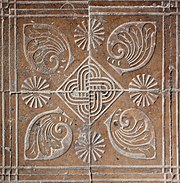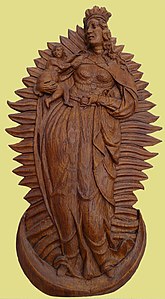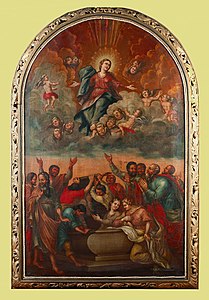Old Chapel (Mülheim-Kärlich)
The old chapel next to the town hall in Mülheim-Kärlich is the oldest preserved building in the city. It was built in the early 14th century, was a Catholic church with a short interruption until 1899, then a school room on the upper floor, later a meeting place and event room for youth groups as well as a church service room for the Protestant parish. Since 1973 the upper floor has been a meeting room for the community and a space for small celebrations.
history
The construction of the chapel, which was under the control of Koblenz's St. Florin Monastery, began in 1313 and, according to a document in the Koblenz city archive, was completed by 1318 at the latest, but without the roof turret. It stands in the Mülheim area on the border to the then electoral garden and belonged as a branch to the parish of Kärlich. It was consecrated to St. Trinity , St. Virgin Mary , St. John the Baptist , St. John the Evangelist and other saints. It was donated by a priest named Johannes in agreement with his sisters. Shortly before his death in 1333, he donated the chapel and all of his property to the order of the Koblenz Carthusian monastery . Associated conditions were, among other things, that the Carthusians gave the chapel's chaplain 10 marks annually on the feast of the Archangel Michael , and provided wax and oil as well as the vestments for the services. In addition, one of his sisters should live in his house and use the garden for life.
In a document from 1459 the house of God is called "Chapel of Our Lady". This name is in about 50 centimeters high bas-relief of a Woman of the Apocalypse words of the 17th century, the capstone may have been attached the choir vault. The original of the relief is in the Diocesan Museum in Trier; Replicas hang on today's upper floor of the chapel and in the city museum. There were probably no major changes to the structure for several centuries and it also survived the Thirty Years' War well. It can even be assumed that the hexagonal roof turret was created during the war years; because a bell from 1630 is said to have been preserved until 1833, which, according to the inscription, had been donated by five citizens, including the Kärlich pastor Anton Doetsch.
In 1695 the chapel received a considerable donation from the fortune of Pastor Caspar Doetsch, a nephew of Anton Doetsch. A clergyman was paid from the proceeds to read a holy mass in the chapel on Sundays and three working days and to pray the rosary on the feasts of Mary . Later the early mass on Sunday was held alternately in Mülheim and Kärlich, during the week on two working days in Mülheim and once in Kärlich. From 1699 the teacher and the bell ringer also received a donation from the foundation.
French revolutionary troops, who destroyed the Kärlich Castle in 1794 , confiscated the chapel and, according to tradition, turned it into a horse stable. In 1807 the chapel was opened again, after which services were held in it until 1891. But in 1869 it had to be demolished in order to build a new, larger church with a rectory in its place. However, since Mülheim belonged to the Kärlich parish at that time and Pastor Jacob Schlecht feared the church's independence of the neighboring town and the loss of the income from the chapel, he thwarted the project, so that the chapel was preserved and the new church in the years 1888 to 1890 to others Place was built.
Right next to the chapel, in addition to two existing school buildings, the “Kapellenschule”, today's town hall, was built, but it soon wasn't enough to accommodate the increasing number of students. Therefore, in 1898/99, a floor ceiling was drawn into the old chapel and the choir was separated by a wall in order to set up another classroom. The basement, used as a storage room, was given a door and three narrow windows on the south side instead of the former west entrance. The choir has also been accessible through an outer door since it was separated from the nave.
In later years the local Kolping Family and the youth used the chapel as a meeting point and event location, and in the 1950s the services of the Protestant parish took place there. Since 1973, the former classroom has been a meeting room for the municipality or city of Mülheim-Kärlich.
architecture
The old chapel is built in the Gothic style. It has a single nave nave with four window axes and a choir with a five-eighth end . Inside, the nave and choir are each 5 meters wide and together 14 meters long. The nave has four two-part windows on each side with four- pass tracery and corresponding pointed arch niches inside. The larger choir windows are designed in the same way.
The choir closes at the top with a ribbed vault and keystone . On the outside the choir is divided by buttresses . Narrow vertical windows on the south side, like the entrances, were broken in 1898 in connection with the division into the lower and upper floors. The former entrance, like a rose window that was walled up in the 19th century, was on the west side.
Nothing is known about the original ceiling of the nave. Before the 1973 renovation, it was a wooden barrel that the windows protruded into. It was replaced by a horizontal ceiling clad with wood. To a slated saddle roof a hexagonal is skylights with a curved hood placed.
A sacristy attached to the east wall in the 18th century has not been preserved.
Furnishing
The table top of the altar probably dates from the early days of the chapel. It is made of tuff and sits on a brick base that may have been made later. To the right of the altar is a two-part sacrarium with simple tracery built into the wall. The ornamental tiles on the floor in the choir are likely to have originated in the 19th century.
- Crescent Madonna, Annunciation Group and Altarpiece from the Old Chapel
In addition to the relief of a crescent moon Madonna, a group of Annunciation from around 1470 was part of the chapel's furnishings, two colored sculptures carved from wood , which are preserved in the Middle Rhine Museum in Koblenz. They show Mary and the Archangel Gabriel , who announces the birth of their child, who will be called the Son of the Most High ( Lk 1,26-38 EU ). The figures are about 60 centimeters high. In terms of style, the sculptures could be assigned to the circle of Niclas Gerhaert van Leyden . An oil painting of the Assumption of Mary , 1.77 × 1.12 meters in size, hung above the altar . After the chapel was profaned , it was first taken to the Mülheim hospital (dissolved in 1969) and has been hanging in the rectory since around 1970.
A carillon has been hanging in the roof turret since 1962 and sounds every hour with a folk melody. In connection with this, a clock with only one hand was attached. Since a renovation in 1990 (year on the dial) it has been two hands, as is common practice.
The upper floor of the old chapel, used as a conference room, is furnished with tables and chairs according to the purpose.
literature
- Winfried Henrichs: 100 years of the parish Maria Himmelfahrt Mülheim. Commissioned by the parish of Mülheim, Mülheim-Kärlich 1987.
- Winfried Henrichs: City chronicle Mülheim-Kärlich. Published by the city of Mülheim-Kärlich, Mülheim-Kärlich 2009.
Individual evidence
- ↑ "Renewed 1898" is carved into the lintel, W. Henrichs: 100 Years Parish Maria Himmelfahrt Mülheim , p. 52, names 1899.
- ^ A b Winfried Henrichs: Mülheim chapel, owned by the Carthusians, Doetsch Foundation . In: 100 years of the parish of the Assumption of Mary . Ed. Parish Mülheim, Mülheim-Kärlich 1987, pp. 39–55.
- ^ Kubach, Michel, Schnitzler: The art monuments of the district of Koblenz . Printed by and published by L. Schwann, reprint 1981, ISBN 3-590-32142-3 , p. 247.
- ↑ Oswald Senner: Up to the top of the choir in the old chapel . In: Mitteilungsblatt Weißenthurm, Linus Wittich Medien, September 19, 2017, p. 13.
- ^ Kubach, Michel, Schnitzler: The art monuments of the district of Koblenz . Printed by and published by L. Schwann, reprint 1981, ISBN 3-590-32142-3 , p. 248.
- ↑ Winfried Henrichs: The Gothic “Old Chapel” in Mülheim-Kärlich . In: Heimatbuch 2017, published by the Mayen-Koblenz district administration, Weiss-Verlag, Monschau, ISSN 0944-1247, p. 202.
Web links
Coordinates: 50 ° 23 ′ 13.2 " N , 7 ° 29 ′ 52.8" E








